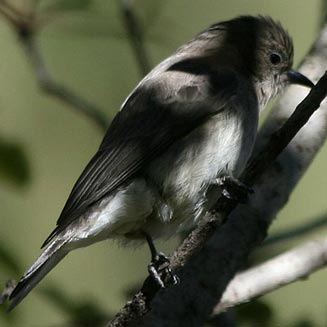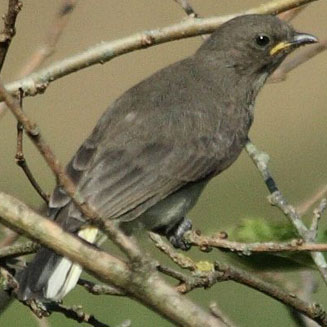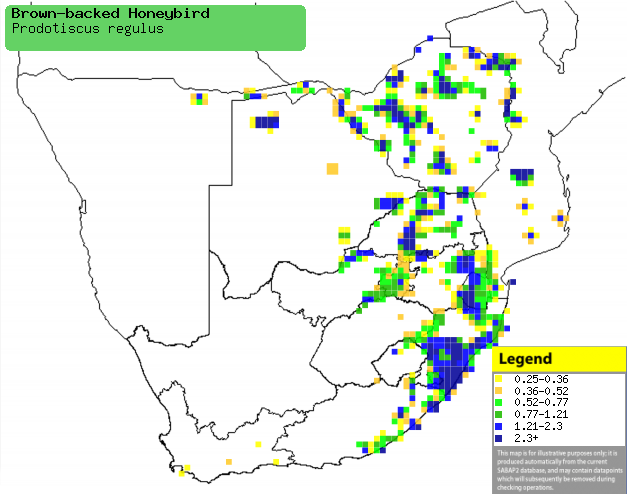|
Prodotiscus regulus (Brown-backed
honeybird, Sharp-billed honeyguide, Wahlberg's honeyguide)
SkerpbekheuningvoŽl [Afrikaans]; Kasoro (generic term for
honeyguide/honeybird) [Kwangali]; Molisa-linotöi (also applied to Lesser
honeyguide) [South Sotho]; Bruinrug-honingspeurder [Dutch]; Indicateur de
Wahlberg [French]; Schmalschnabel-honiganzeiger [German]; Indicador-de-bico-aguÁado
[Portuguese]
Life
> Eukaryotes >
Opisthokonta
> Metazoa (animals) >
Bilateria >
Deuterostomia > Chordata >
Craniata > Vertebrata (vertebrates) > Gnathostomata (jawed
vertebrates) > Teleostomi (teleost fish) > Osteichthyes (bony fish) > Class:
Sarcopterygii (lobe-finned
fish) > Stegocephalia (terrestrial
vertebrates) > Tetrapoda
(four-legged vertebrates) > Reptiliomorpha > Amniota >
Reptilia (reptiles) >
Romeriida > Diapsida > Archosauromorpha > Archosauria >
Dinosauria
(dinosaurs) > Saurischia > Theropoda (bipedal predatory dinosaurs) >
Coelurosauria > Maniraptora > Aves
(birds) >
Order: Piciformes
> Family: Indicatoridae
 |
 |
|
Brown-backed honeyguide, Cavern Resort,
KwaZulu-Natal Drakensberg, South Africa. [photo
Alan Manson
©] |
Brown-backed honey guide juvenile,
Pietermaritzburg, South Africa. [photo
Alan Manson
©] |
For information about this species, see
www.birdforum.net/opus/Wahlberg's_Honeyguide
Distribution and habitat
Occurs in patches in West Africa and the area from Tanzania
and southern DRC to Angola, Zambia and southern Africa. Here it is uncommon to
locally common in the Caprivi Strip (Namibia), northern and eastern Botswana,
Zimbabwe, southern Mozambique, Swaziland and eastern South Africa. It generally
prefers savanna, thickets, open woodland, thorn scrub and forest edges,
especially if the area has alien trees with abundant scale-insects (Coccoidea).
|
 |
|
Distribution of Brown-backed honeybird in southern Africa,
based on statistical smoothing of the records from first SA Bird Atlas
Project (©
Animal Demography unit, University of
Cape Town; smoothing by Birgit Erni and Francesca Little). Colours range
from dark blue (most common) through to yellow (least common).
See here for the latest distribution
from the SABAP2. |
Movements and migrations
Largely resident, although it may make seasonal
movements, as it is most common in KwaZulu-Natal in Winter when many
other honeyguides are scarce.
Food
Mainly eats scale-insects and other insects, doing most of
its foraging by gleaning from foliage, twigs and bark while occasionally hawking
prey aerially. The following food items have been recorded
in its diet:
Breeding
- Brood parasite, laying its eggs in the other bird nests; the following
birds have been recorded as hosts:
- Egg-laying season is from November-January, peaking in November.
- It usually lays a single egg per nest, occasionally up to three, which
are incubated by the host bird.
- The chicks are fed by the hosts on a diet of mainly termite alates,
leaving the nest after 17-21 days.
Threats
Status uncertain, as it is inconspicuous and probably
under-recorded, however it is range has expanded to the south-west with the
spread of alien trees, so it is probably not threatened.
References
-
Hockey PAR, Dean WRJ and Ryan PG 2005. Roberts
- Birds of southern Africa, VIIth ed. The Trustees of the John Voelcker
Bird Book Fund, Cape Town.
|
